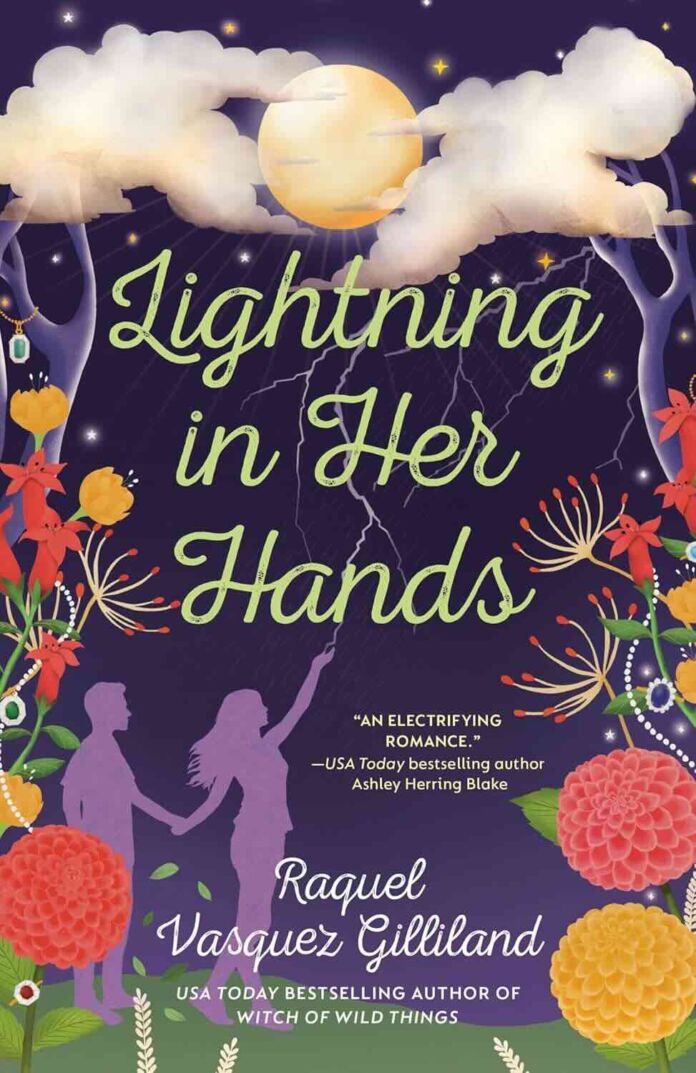In a world where magic intertwines with everyday life, where emotions manifest as weather patterns and family secrets brew like thunderstorms, Raquel Vasquez Gilliland crafts a tale that explores the complexity of love, trauma, and self-acceptance. Lightning in Her Hands, the second installment in the Wild Magic series, delivers a unique blend of magical realism and contemporary romance that both enchants and challenges readers.
The Story’s Heart
Teal Flores has always struggled with her magical gift—the ability to influence weather through her emotions. Unlike her sisters Sage (who communicates with plants) and Sky (who connects with animals), Teal’s power seems broken, volatile, and dangerous. When she needs a date to her ex’s wedding, she turns to her childhood best friend Carter Velasquez with a proposition: fake marriage in exchange for helping him secure his inheritance. What begins as a convenient arrangement evolves into a journey of healing, self-discovery, and the kind of love that can weather any storm.
Strengths & Magic
- Rich Cultural Tapestry Gilliland weaves Mexican American culture seamlessly into the narrative, from family dynamics to cultural traditions. The incorporation of Spanish language and Latine family structures feels authentic rather than tokenistic, enriching the story’s texture.
- Complex Family Dynamics The relationship between the Flores sisters—Teal, Sage, and Sky – forms the emotional backbone of the story. Their bond, complicated by past trauma and Sky’s mysterious eight-year disappearance, provides depth beyond the romance plot.
- Magical System The author’s interpretation of magical gifts tied to natural elements is both innovative and metaphorically rich. The connection between emotional health and magical control creates an engaging parallel to real-world mental health discussions.
Areas for Growth
- Pacing Inconsistencies The middle section of the novel occasionally drags, particularly during the build-up to confronting Teal’s mother. Some subplots, like the investigation into her mother’s whereabouts, feel underdeveloped compared to the romance storyline.
- Character Development While Teal’s growth is well-crafted, some secondary characters, particularly antagonists like Erika and Leilani, can feel one-dimensional at times. Their motivations could have been explored with more nuance.
- Plot Predictability The fake marriage trope, while enjoyable, follows fairly predictable patterns. Some readers might find the romantic resolution too convenient, though Gilliland’s unique magical elements help offset this familiarity.
Writing Style & Voice
Gilliland’s prose shines brightest in emotional moments, particularly when describing the intersection of magic and feeling. Her metaphors involving weather and natural phenomena are particularly striking. However, the dialogue occasionally feels stilted, especially in confrontational scenes.
The author’s background as a poet shows in her lyrical descriptions: “The sky has turned from bright and blue to overcast gray that’s about as cheery as a pile of cinder blocks.”
Themes & Impact
- Self-acceptance and healing from trauma
- The complexity of mother-daughter relationships
- Mental health and emotional regulation
- Cultural identity and family legacy
- The power of choosing love despite fear
Romance & Chemistry
The relationship between Teal and Carter develops with a satisfying slow burn. Their shared history adds depth to their connection, though some readers might find the resolution of their conflicts too neat. The physical chemistry is well-written without being gratuitous.
Comparison to Book 1
While Witch of Wild Things (featuring Sage’s story) focused more on plant magic and family curses, Lightning in Her Hands takes a deeper dive into emotional trauma and self-discovery. Both books stand alone well but are enriched by reading them in sequence.
Final Verdict
Despite some structural weaknesses, the novel succeeds in creating an engaging romantic fantasy that tackles serious themes while maintaining its magical charm. Gilliland’s unique voice and cultural perspective make this a worthwhile addition to the contemporary fantasy romance genre.
Recommended for Readers Who Enjoy:
- Magical realism
- Contemporary fantasy romance
- Family-centered narratives
- Cultural fiction
- Mental health themes in literature
Similar Books:
- The Ex Hex by Erin Sterling
- The Very Secret Society of Irregular Witches by Sangu Mandanna
- A Proposal They Can’t Refuse by Natalie Caña
Author Background
Raquel Vasquez Gilliland brings her experience as a Mexican American poet and cultural anthropologist to her fiction, enriching her storytelling with authentic cultural elements and lyrical prose. Her previous works include young adult novels Sia Martinez and the Moonlit Beginning of Everything and How Moon Fuentez Fell in Love with the Universe.
Final Thoughts
Lightning in Her Hands might not be perfect, but its unique blend of magical realism, cultural authenticity, and emotional depth makes it a memorable addition to the fantasy romance genre. Gilliland’s exploration of trauma, healing, and love through the lens of weather magic creates a story that resonates beyond its supernatural elements.
The novel’s greatest strength lies in its honest portrayal of emotional healing and the courage it takes to love despite past hurts. While some plot elements follow familiar patterns, the author’s distinct voice and cultural perspective elevate the story above typical romance tropes.
For readers seeking a romance that balances magical elements with realistic emotional depth, Lightning in Her Hands offers a storm worth weathering.





